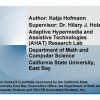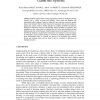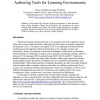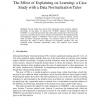AIED
2005
Springer
14 years 5 months ago
2005
Springer
Measuring the efficacy of ITS can be hard because there are many confounding factors: short, well-isolated studies suffer from insufficient interaction with the system, while longe...
AIED
2005
Springer
14 years 5 months ago
2005
Springer
AIED
2005
Springer
14 years 5 months ago
2005
Springer
Students approach the learning opportunity offered by intelligent tutoring systems with a variety of goals and attitudes. These goals and attitudes can substantially affect student...
AIED
2005
Springer
14 years 5 months ago
2005
Springer
The research literature investigating the construction of tutorial dialogue and learning companion environments present parallel experiences in attempting to emulate what has been ...
AIED
2005
Springer
14 years 5 months ago
2005
Springer
Time on task is an important predictor for how much students learn. However, students must be focused on their learning for the time invested to be productive. Unfortunately, stude...
AIED
2005
Springer
14 years 5 months ago
2005
Springer
Course material for electronic learning environments is often structured using schema languages. During the specification and development of course material, many mistakes can be m...
AIED
2005
Springer
14 years 5 months ago
2005
Springer
AIED
2005
Springer
14 years 5 months ago
2005
Springer
: Two problem solving strategies, forward chaining and backward chaining, were compared to see how they affect students’ learning of geometry theorem proving with construction. I...
AIED
2005
Springer
14 years 5 months ago
2005
Springer
: Several studies have shown that explaining actions increases students’ knowledge. In this paper, we discuss how NORMIT supports self-explanation. NORMIT is a constraint-based t...
AIED
2005
Springer
14 years 5 months ago
2005
Springer
Abstract: The problem of modeling and assessing an individual’s ability level is central to learning environments. Numerous approaches exists to this end. Computer Adaptive Testi...




